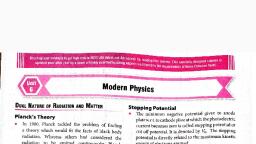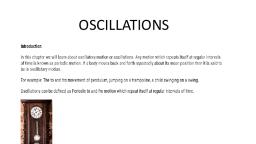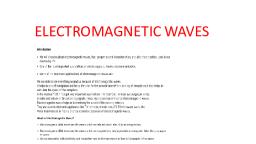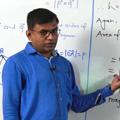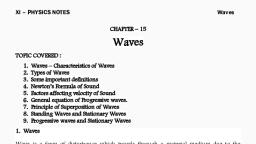Page 1 :
STRING WAVES, , UCTION, wrROP omave isa disturbance which travels or Propagates, , and transports energy and momentum without the, jransport of matter. The ripples on a pond, the sound, we hear, visible light, radio and TV signals are a few, examples of waves. Sound, light and radio waves, provide us with an effective means of transmitting, and receiving energy and information., , Waves are of two types : mechanical and, electromagnetic., , Mechanical waves require material medium for their, propagation. Elasticity and density of the medium play, an important role in propagation of mechanical waves,, That is why the mechanical waves sometimes are, referred to as elastic waves., , Electromagnetic waves require absolutely no material, medium for their propagation. They can travel through, vacuum. Light, TV signals, radio waves, X-rays, etc., are examples of nonmechanical waves. These are, electromagnetic in nature. In an electromagnetic, wave, energy travels in the form of electric and, magnetic fields., , CLASSIFICATION OF WAVES, There are three ways of classifying mechanical waves., L Based on Direction of Motion of Particles, Waves differ from one another in the manner the, particles of medium oscillate (or vibrate) with reference, to the direction of propagation., , (i) Transverse Waves : In such waves, the oscillatory, motion of the particles of the medium is transverse to, the direction of propagation. Consider the wave, travelling along a rope., , , , The direction of propagation of the wave is along the, ‘Spe, but the individual particles of the rope vibrate, “P and down. The electromagnetic wave (light, radio, Waves, X-rays, etc.) although not mechanical, but said, , be transverse, as the electric and magnetic field, , , , , , (ii), , (), , , , vibrate in direction perpendicular to the direction of, Propagation., , Longitudinal Waves : In these waves, the direction of, vibration of the particles of the medium is parallel to, the direction of propagation., , The figure shows a long and elastic spring. When we, repeatedly push and pull one end of the spring, the, compressions and rarefaction of the spring travel, along the spring. A particle on the spring moves back, and forth, parallel and anti-parallel to the direction of, the wave velocity., , Sound waves in air are also longitudinal. Some waves, (for example, ripples on the surface of a pond) are, neither transverse nor longitudinal but a combination, of the two. The particles of the medium vibrate up and, down, and back and forth simultaneously describing, ellipses in a vertical plane., , In strings, mechanical waves are always transverse,, when the string is under a tension., , In gases and liquids, mechanical waves are always, longitudinal, e.g., sound waves in air or water. This is, because fluids cannot sustain shear. They do not, posses rigidity. They posses volume elasticity,, because of which the variations of pressure (i.e.,, compressions and rarefactions) can travel through, them. For this reason, the longitudinal waves are also, called pressure waves., , In solids, mechanical waves (may be sound) can be, either transverse or longitudinal depending on the, mode of excitation. The speeds of the two waves in, the same solid are different (longitudinal waves travel, faster than transverse waves)., , Based on Dimensionality of Propagation, One-dimensional wave travels along a straight line,, €.g., waves produced on a string., , Two-dimensional wave propagates @, , water ripples, vibration of the s .€, Three-dimensional wave propaga, , e.g., sound waves., Based on Particle Behaviour in 1, These can be two types of wave}, wave train, :, Wave pulse : In this case, the, the medium has following tim, particle is in equilibrium (no, some type of motion or dis, returns to it equilibrium pos:
Page 2 :
Waves, , , , (Eampiet) _, , Sel., , (ii), , transverse wave, one end of the string up and down., As the displacement pulse travels along, nei 5 : xp, particle in the string begins at rest, XP a, displacement as the pulse passes through it, and th, retums to the equilibrium., ‘ j e, Wave Train : In a wave train all the particles oe, medium undergo a continuous periodic motion. ry, continuous succession of pulses constitutes & wnive:, train. Specially, if the periodic motion of the particles, is simple harmonic motion, the wave is called, , sinusoidal wave train., , pas, SOLVED EXAMPLE, , , , the string each, riences 4, , : Ie Poet a I elt eens, A mechanical wave moving in a gas , (A) must be longitudinal (B) maybe longitudinal, (C) must be transverse (D) may be transverse, , (A) Mechanical wave moving in a gas must be, , longitudinal., , , , (Example), , The property of medium necessary for wave, propagation is its , (A) Inertia (B) Elasticity, , (C) Low resistance (D) All of above, , (D) Necessary property of medium to wave, propagation are, , (i) Inertia (ii) Elasticity, (iii) low resistance of medium, , (Example3, , Elastic waves in solid are , (A) Transverse, , (B) Longitudinal, , (C) Either transverse or longitudinal, (D) Neither transverse nor longitudinal, , Sol (C) By Theory., Elastic waves in solid are either transverse or, longitudinal. Transverse on surface and longitudinal, in volume., , WAVE FUNCTION, , 102, , The disturbance created by a wave is represented by, wave function. For a string, the wave function is a, (Vector) displacement; whereas for sound waves, it is, (scalar) pressure or density fluctuation. In the case of, light or radio waves, the wave function is either an, electric or magnetic field vector., , (a) Mathematical Representation of Wave Function, Consider a disturbance or a pulse travelling along xdirection with a velocity v. Let us look at this pulse, from two different frames of reference. The xy-frame ig, , , , , , , , , , , , , stationary, whereas the other frame x’y/ j, mov;, velocity v along x-axis, aS shown in the figat, , assume that the origins of the two frames concey®, t=0., , y Ay v, —— |, , , , , , oO, , Q, Le, , In the moving frame, the pulse appears to be at res,, since both the pulse and the x'y’-frame are moving, with the same velocity v. Therefore, at any time the, vertical displacement y’ at position x’ is given by some, function fix’) that describes the shape of the pulse,, y'=f’) @, In the stationary frame, the pulse has the same shape, but it is moving with a velocity v. It means that the, displacement y is a function of both x and ¢., The coordinates of any point on the pulse as measured, in the two frame are related as, , oy, x =x-vt, , Thus, Eq. (i) may be modified as, y=fe—v) i), , This equation represents a wave motion along +v¢*, , direction., , Any given feature (phase) of the pulse, for example,, , its peak, has a fixed value of x’. It means that, x' =x—vt= constant...) 9, , The quantity (x — vr) is called, , function., , Differentiating Eq. (iii) wrt. ti, , where v is the wave velocity or,, velocity at which a parti, disturbance travels through, travelling along the negative x:, is given by Eq. (ii) modified as, dn general, the wave motion in, by |, y= f(xFot), (b) The Wave Equation, , A travelling wave satisfi, the linear wave equi
Page 3 :
HARMONIC WAVE TRAIN, , , , Wave. When such a wave passes |, Tegion, the particles of the mediul, , Al-D(one dimensional) plane prog, most general form is given by, , , , ax space and time which satisfies above (”), tio? ation is 2 traviling wave., , eZ Asin @t or y=A sin kx do not, , ti ns yatiod, hence do not represent waves,, , uy ao¥e os 4; functions such as, , . i ‘A sin (kx —, Bi Zoi asin ke sn ah | sin (kx — wt) + B, , / [a+ (ax — bt, Ae Beat?, + WE) I+, , os ot) satisfy the wave equation, and, 2 (kx —, , cos ave functions., of ‘ these are Wi, hen, , @G), , , , , , , , , , , , , ction to be wave function, the three, tand v must appear in the linear, ° yt) or (x + vé). Thus, (x— vet) is, , qations ~ fs, corbin’ yA) is not. (because it is not, , soceptable but ("~, finest), , ‘on ne i is and vice-versa, i travelling along positive x-axis an /, is, , between t and x implies that the wave, , , , The wave function of a pulse is given by, , 3, Yo x41), , i locity of the pulse, nds. Determine the wave veloc, and indicate the direction of propagation of the wave., , is i etres and t is, , where y 18 in m, , On comparing the given expression with, y=f(x- vt), we get the velocity of the wave as, v=4m/s ., i i tin, Since there occurs negative sign between ee fe, the given expression, the wave propagates, , , , , , , , , , , Ifthe source of the wave is a simple, the function f(x + vé) is sinusoidal a, harmonic wave train or simply, 4, , onic motion., , Y= Asin(kx F ot + $0), , nar, i:, , meteates, rtm, , Cleart eran, Y a set of oe Weve, completely des, four paameten ., , C ers 4, ctibes Sl, Astin hn a plane Progressive ie It Tepresents the m:, Boris 44, TOM its equilibtiam Position., , Phase Constant (), The phase consta, , aximum value of the ‘Wave function, i, , , then 4, will be ‘, usually the case with a wave Henes pe iolenn _, = assume, , , = 0 and the i, wave is travelli, unless stated otherwise. InBalong positive s-axis, , Angular Frequency (@), , At a given position, the wave func ‘ion at is, ion, th functi time, 1s, , ime, , y' =A sin (for — ot’), The wave will repeat itself, ify’ =y or ¢ =1+ (2n/m), [as sin (0 + 27) = sin 6], , The time after which a wave repeats itself is called, time period (7), given by, , 2n, T=t-t=—, o, , It is exactly the same time that it takes for one, wavelength to pass the point., , Further, the rate at which the wave repeats itself is, called its frequency (/),, , 1_o, f= T 2n, The SI unit of fis Hz (Hertz)., , It is same as the number of complete vibrations of a, point that occur in one second., The angular frequency (@)is related to the frequency, , as, , w=20f, , ‘ sarah, q@is measured in ra aes, Note that © for Tare the characteristics oF - —, ' independent 0, ing the wave and are in, uoihnd in which the Wave propagates., , tion constant (X), , , , ofa, , length as ss, points yibral
Page 4 :
©, , Phase Difference and Path Difference, The argument of the harmonic flanctton., y= Asin (kr- r+ @,), is called phase of the wave, > Thus,, om kx arg, @ ;, The phase @ changes both with dystance U and ya, The change in phase AG with change 1" time i, fixed value of 1 is found by partially differential, ogn (i) wrt has, , >, , an, N@ = alr Nt, T, 2n, Ae = Nt @, e, , Similarly, the change in phase Ad with change 10, distance Ax for fixed value of time fis given as, , %, , A@=kAr= = Ax, A, , 2x, de=— Ar a), A, , The change in x is also called path difference. If Av=, A, we get AG = 2. That is, a path difference a, corresponds to a phase difference of 27 rad., , (ExampicS ), , 104, , ‘The equanon of a transverse wave in a stretched string, ws given as, , fx t |, y=2sin2x 139 0.01, where y and x are cm and tis in s. Find, (a) the amphtude (b) the frequency, (c) the wavelength, and (d) the wave velocity, , Comparing the given equation with the standard, equation,, , {2x 2n, y= 4 sin (x of) Asin Et, , a T, deh, ~Ammln i T!, We get, (a) amplitude, 4 = 2. cm, 1 i, (b) frequency, f = ani" 100 He, , (o) weve length 2 = 30 cm, {d) wave velocity, » =f. = 100.39 «, , 3000 ¢, = Wms ony, , , , , , , , sjocity of sound in ag, Jeulate the ve =, sirference in frequencies Of VO Waves : a, 1.0 mand | Ol mis4 Hz., , Let the frequencies of the (Wo Waves be 4, dy,, , , , , , hae? Thy, Since, ¥* fr, we can write, y «4, A, Aa, sf ots a 4, an Ce, \ as, or (re 1.01, 101), —— |= 404 ms", { oo J 404m, A progressive wave of frequency 500 Hz is traveling, with a velocity of 360 m/s. How far apart are two pan,, 60° out of phase ?, Sol. We know that for a wave v= fh., v_ 360, Aso T=0.72, f 500°, n X, Ad = 60°= 60°=—, Given Ad 777 znd, Qn, We know that phase difference, 4 = 7 (put, difference, Ax), 4 0.72 ©, Axa a Aba XG 702m, WAVE VELOCITY, , , , The wave, velocity of, the medium,

















